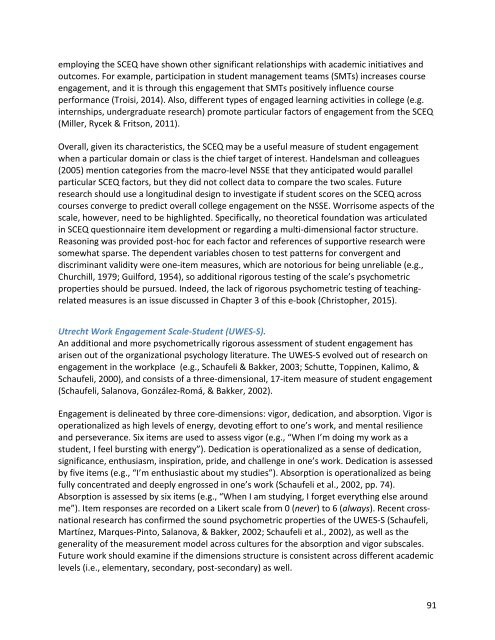A COMPENDIUM OF SCALES for use in the SCHOLARSHIP OF TEACHING AND LEARNING
compscalesstl
compscalesstl
Create successful ePaper yourself
Turn your PDF publications into a flip-book with our unique Google optimized e-Paper software.
employ<strong>in</strong>g <strong>the</strong> SCEQ have shown o<strong>the</strong>r significant relationships with academic <strong>in</strong>itiatives and<br />
outcomes. For example, participation <strong>in</strong> student management teams (SMTs) <strong>in</strong>creases course<br />
engagement, and it is through this engagement that SMTs positively <strong>in</strong>fluence course<br />
per<strong>for</strong>mance (Troisi, 2014). Also, different types of engaged learn<strong>in</strong>g activities <strong>in</strong> college (e.g.<br />
<strong>in</strong>ternships, undergraduate research) promote particular factors of engagement from <strong>the</strong> SCEQ<br />
(Miller, Rycek & Fritson, 2011).<br />
Overall, given its characteristics, <strong>the</strong> SCEQ may be a <strong>use</strong>ful measure of student engagement<br />
when a particular doma<strong>in</strong> or class is <strong>the</strong> chief target of <strong>in</strong>terest. Handelsman and colleagues<br />
(2005) mention categories from <strong>the</strong> macro-level NSSE that <strong>the</strong>y anticipated would parallel<br />
particular SCEQ factors, but <strong>the</strong>y did not collect data to compare <strong>the</strong> two scales. Future<br />
research should <strong>use</strong> a longitud<strong>in</strong>al design to <strong>in</strong>vestigate if student scores on <strong>the</strong> SCEQ across<br />
courses converge to predict overall college engagement on <strong>the</strong> NSSE. Worrisome aspects of <strong>the</strong><br />
scale, however, need to be highlighted. Specifically, no <strong>the</strong>oretical foundation was articulated<br />
<strong>in</strong> SCEQ questionnaire item development or regard<strong>in</strong>g a multi-dimensional factor structure.<br />
Reason<strong>in</strong>g was provided post-hoc <strong>for</strong> each factor and references of supportive research were<br />
somewhat sparse. The dependent variables chosen to test patterns <strong>for</strong> convergent and<br />
discrim<strong>in</strong>ant validity were one-item measures, which are notorious <strong>for</strong> be<strong>in</strong>g unreliable (e.g.,<br />
Churchill, 1979; Guil<strong>for</strong>d, 1954), so additional rigorous test<strong>in</strong>g of <strong>the</strong> scale’s psychometric<br />
properties should be pursued. Indeed, <strong>the</strong> lack of rigorous psychometric test<strong>in</strong>g of teach<strong>in</strong>grelated<br />
measures is an issue discussed <strong>in</strong> Chapter 3 of this e-book (Christopher, 2015).<br />
Utrecht Work Engagement Scale-Student (UWES-S).<br />
An additional and more psychometrically rigorous assessment of student engagement has<br />
arisen out of <strong>the</strong> organizational psychology literature. The UWES-S evolved out of research on<br />
engagement <strong>in</strong> <strong>the</strong> workplace (e.g., Schaufeli & Bakker, 2003; Schutte, Topp<strong>in</strong>en, Kalimo, &<br />
Schaufeli, 2000), and consists of a three-dimensional, 17-item measure of student engagement<br />
(Schaufeli, Salanova, González-Romá, & Bakker, 2002).<br />
Engagement is del<strong>in</strong>eated by three core-dimensions: vigor, dedication, and absorption. Vigor is<br />
operationalized as high levels of energy, devot<strong>in</strong>g ef<strong>for</strong>t to one’s work, and mental resilience<br />
and perseverance. Six items are <strong>use</strong>d to assess vigor (e.g., “When I’m do<strong>in</strong>g my work as a<br />
student, I feel burst<strong>in</strong>g with energy”). Dedication is operationalized as a sense of dedication,<br />
significance, enthusiasm, <strong>in</strong>spiration, pride, and challenge <strong>in</strong> one’s work. Dedication is assessed<br />
by five items (e.g., “I’m enthusiastic about my studies”). Absorption is operationalized as be<strong>in</strong>g<br />
fully concentrated and deeply engrossed <strong>in</strong> one’s work (Schaufeli et al., 2002, pp. 74).<br />
Absorption is assessed by six items (e.g., “When I am study<strong>in</strong>g, I <strong>for</strong>get everyth<strong>in</strong>g else around<br />
me”). Item responses are recorded on a Likert scale from 0 (never) to 6 (always). Recent crossnational<br />
research has confirmed <strong>the</strong> sound psychometric properties of <strong>the</strong> UWES-S (Schaufeli,<br />
Martínez, Marques-P<strong>in</strong>to, Salanova, & Bakker, 2002; Schaufeli et al., 2002), as well as <strong>the</strong><br />
generality of <strong>the</strong> measurement model across cultures <strong>for</strong> <strong>the</strong> absorption and vigor subscales.<br />
Future work should exam<strong>in</strong>e if <strong>the</strong> dimensions structure is consistent across different academic<br />
levels (i.e., elementary, secondary, post-secondary) as well.<br />
91


